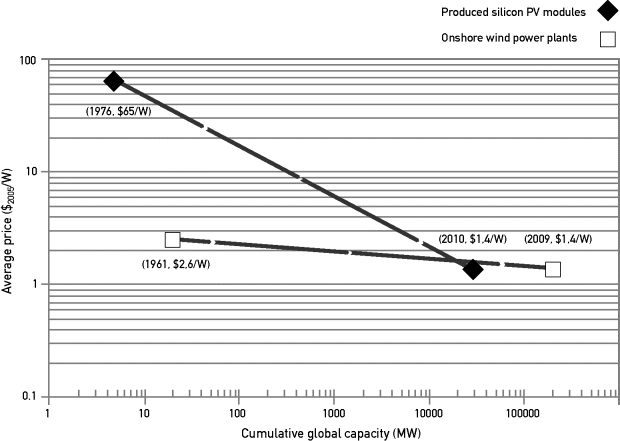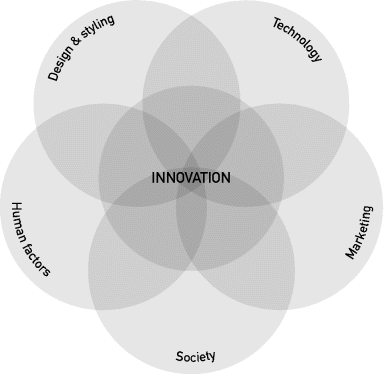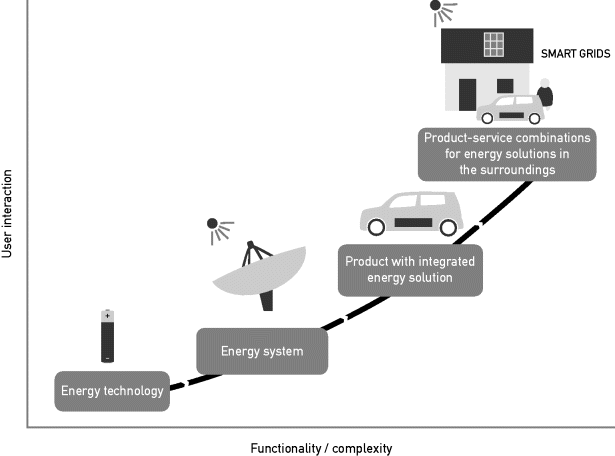1.3 Sustainable Energy and Product Design
From a technical point of view, a lot of opportunities for and applications of sustainable energy technologies already exist. However, the way in which sustainable energy solutions will be offered to the market and end users will help to decide their success and thus their effectiveness in providing solutions for greenhouse gas reduction and energy security in the short and long term. Therefore, in our opinion product design could play an important role in developing sustainable energy solutions that can be incorporated into products or the environment. This will be explained in this section, which covers a brief history of the conceptual term energy solutions.
Until the early 2000s, as a rule, the expression energy solution was directly translated as energy system. This engineering approach focused on technical aspects, which may be translated more or less by a desire to increase a technology's energy yield. As an example, in the last 35 years due to successful R&D the efficiency of different types of solar cells was increased by a factor of approximately 4, leading to efficiencies of 40% and higher (Kazmerski, 2011). The end of these developments is not yet in sight, and efficiencies of over 50% are predicted in the nearby future. Similar upward trends in energy efficiencies can be observed for other renewable technologies such as wind turbines, fuel cells, and light-emitting diodes (LEDs).
At the same time, people aimed for a significant reduction in renewable-energy technology costs. This objective was accompanied by a vision of large-scale implementation of renewable energy. Figure 1.3.1 shows evidence of the success of this strategy in the reduction in solar panel and wind turbine prices versus their cumulative capacity; that is, in a period of 35 years the average price of photovoltaic (PV) modules went down with a factor of 50. A 50% cost reduction was achieved for wind power plants in a period of 30 years.
Figure 1.3.1 Price development of wind farms and PV modules versus cumulative capacity; data from IPCC (2011)

To stimulate the application and use of renewable energy, energy policy and legislation were developed and introduced. An example is the realization of feed-in tariffs for renewable electricity to the grid. These developments have become effective in many countries. In 2010, 96 countries had a policy for the use of renewable energy and 87 countries offered dedicated rates for renewable power fed into the grid (REN21, 2011).
Also, citizens influence energy choices. This was shown in March 2011 in Germany, where the social acceptance of nuclear energy was already under discussion. However, after the disaster of the Fukushima Daiichi nuclear power plant in Japan, the German population demanded with great protest an inherently secure and sustainable energy provision. This request was heard: The German government revised its policy to ensure the closure of 17 nuclear power plants by 2022.
Ultimately, the consumer – or end user – plays an important role in the acceptance of new forms of energy and energy efficiency, also at the level of use of energy systems. Through field research into the functioning of small-scale autonomous solar systems called solar home systems in Indonesia in the late 1990s (Reinders et al., 1999), it was concluded that user interaction with an energy system can affect (1) the quality of the system's function, namely, electricity supply; and (2) the corresponding perception of usefulness and comfort by the end user (Figure 1.3.2).
Figure 1.3.2 Impressions of typical use circumstances of solar home systems in Java, Indonesia (pictures courtesy of Angèle Reinders)

User aspects will also become relevant with the introduction of Smart Grids. Smart Grids are power networks that intelligently integrate the behavior of all users – producers, consumers, and combinations of them – in order to efficiently provide sustainable, affordable, and reliable electricity (ETPS, 2011). The main assumption regarding smart grids is that the electricity sector will significantly become more sustainable over the next 10 years by the use of information and communications technology (ICT), renewable energy systems, and feedback on energy consumption for end users (IEA, 2011). The Smart Grids concept covers various aspects: (1) the distribution infrastructure (low and medium voltage), (2) distributed electricity generation, (3) energy management, (4) demand-side management among consumers, and possibly (5) energy storage. At the level of households and consumers, small-scale distributed energy systems in, on, and around the home – or at the district level – will become common in the nearby future. In this new situation, the end user will be confronted with various new energy technologies that will be introduced into the household, as well as with price effects due to the choice of purchasing electricity from the grid or creating self-generated power and the associated energy savings. The end user will have to learn to deal with this.
In summary, the term energy solution comprises energy's technical and financial aspects, societal aspects, and user aspects. Adding to this, one may assume that the visibility of small- to medium-scale energy solutions is increased by integrating them into a user environment, for which reason aesthetics will come into play. Examples of visible sustainable technologies such as LEDs, solar cells, and wind turbines are shown by different lighting products in Figure 1.3.3.
Figure 1.3.3 Different lighting products based on sustainable technologies, right: Virtue of Blue by DeMakersVan (2010)

In the context of product development, the following aspects are all of equal importance for the design of a successful product: technologies, finance, society, human factors, and design and styling. Conversely stated, if these five aspects are applied in the development of an energy solution, one may speak of product design and product development. Therefore, we assume that an interdisciplinary approach to the aforementioned problems with energy consumption, durability, cost, social aspects, and users can create better solutions than using a monodisciplinary approach that focuses only on improving energy technologies. In other words, we assume that energy solutions based on these five aspects will be innovative (Figure 1.3.4).
Figure 1.3.4 Innovation flower of industrial product design

An interdisciplinary design-based approach to energy is not just a throw in the air. It even seems necessary because the complexity, functionality, and user interaction of energy solutions are increasing as more products are integrated in an operating environment, also called surroundings. Figure 1.3.5 explains this statement by showing the development of energy technologies to energy systems, in this case a solar concentrator system, whose primary function is energy production. Subsequently integration takes place with products such as a fuel cell–powered car, or with surroundings like an interactive public lighting system. In operation, energy-efficient LEDs interactively respond to sound and warmth and for this reason only illuminate space in the vicinity of people. If this public lighting system doesn't detect people, it turns itself off, leading to a reduction of the total energy consumption compared to conventional public lighting systems.
Figure 1.3.5 Energy solutions in relation to an increasing degree of integration in products or environments

We foresee that user interactions with new energy products and services will strongly influence their energy efficiency and sustainability. The mechanisms and their effectiveness are still largely unknown, and depend on the type of products and services; for instance, user interaction with a solar-powered portable product will differ significantly from user interaction with a Smart Grid. Therefore, it will be interesting and significant to intensively consider the user when developing energy solutions.
